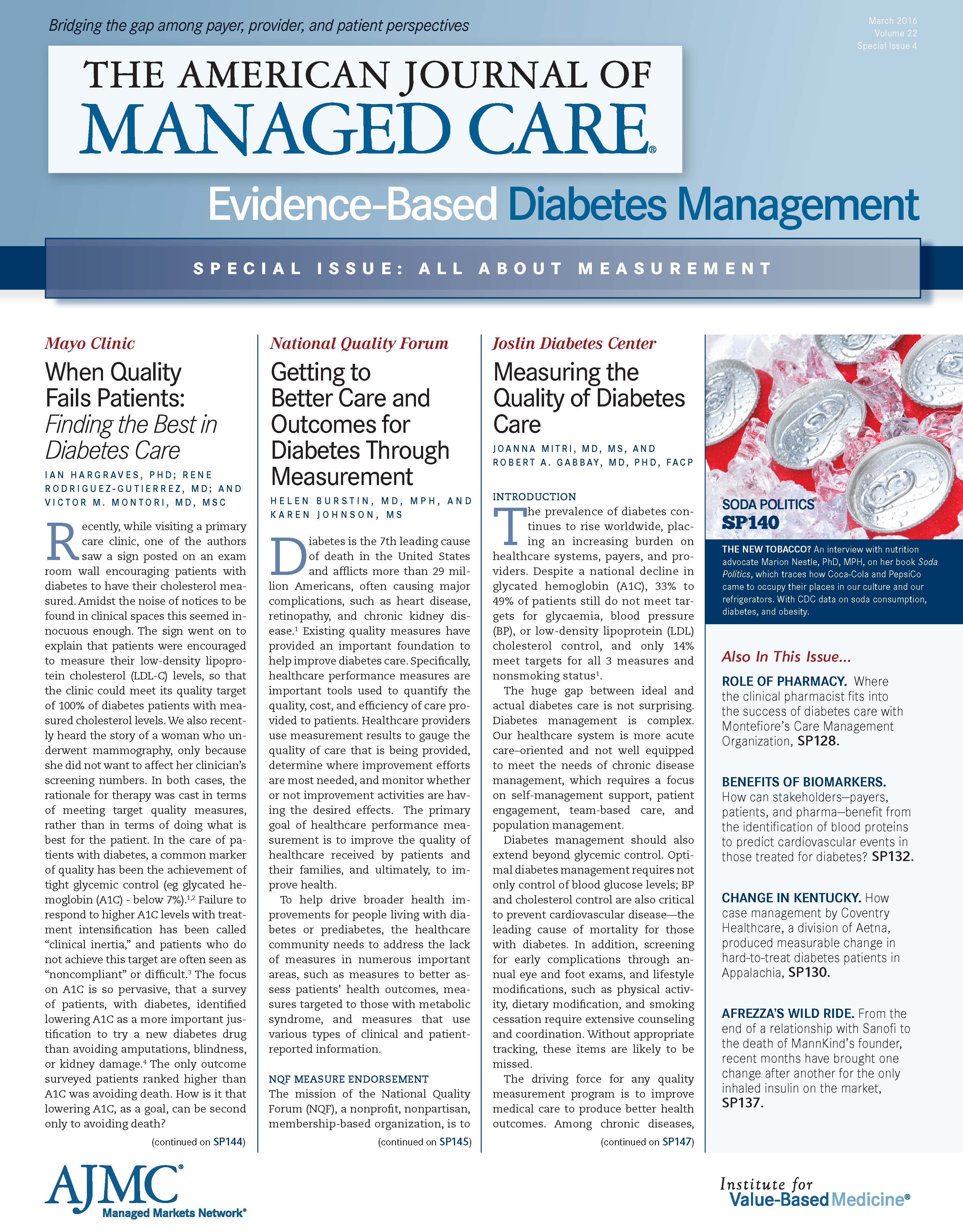Publication
Article
Evidence-Based Diabetes Management
Measuring the Quality of Diabetes Care
An introduction to the Joslin Clinical Analytic Tool, a new diabetes measure developed to adjust for the variety in patient mix and better inform clinicians which interventions will work best.
INTRODUCTION
The prevalence of diabetes con­tinues to rise worldwide, plac­ing an increasing burden on healthcare systems, payers, and pro­viders. Despite a national decline in glycated hemoglobin (A1C), 33% to 49% of patients still do not meet tar­gets for glycaemia, blood pressure (BP), or low-density lipoprotein (LDL) cholesterol control, and only 14% meet targets for all 3 measures and nonsmoking status1.
The huge gap between ideal and actual diabetes care is not surprising. Diabetes management is complex. Our healthcare system is more acute care—oriented and not well equipped to meet the needs of chronic disease management, which requires a focus on self-management support, patient engagement, team-based care, and population management.
Diabetes management should also extend beyond glycemic control. Opti­mal diabetes management requires not only control of blood glucose levels; BP and cholesterol control are also critical to prevent cardiovascular disease—the leading cause of mortality for those with diabetes. In addition, screening for early complications through an­nual eye and foot exams, and lifestyle modifications, such as physical activ­ity, dietary modification, and smoking cessation require extensive counseling and coordination. Without appropriate tracking, these items are likely to be missed.
The driving force for any quality measurement program is to improve medical care to produce better health outcomes. Among chronic diseases, diabetes has been a focus of performance measurement for many years, and it stands as one of the first conditions for which disease-specific indicators based on evidence-based clinical guidelines have been used to evaluate the quality of care and preventive services.2-4
Standardized performance measures are needed in order to assess the quality of care in the United States. CMS, the National Committee on Quality Assurance (NCQA), and the American Diabetes Association (ADA) led the first national ef­fort to develop a set of performance measured for diabetes.2 The Diabetes Quality Improvement Program measures were first adopted by NCQA to use in the Healthcare Effectiveness Data and Information Set (HEDIS) and subsequently widely adopted for performance assessment in commercial, Medi­care, and Medicaid health plans.
CURRENT STATUS OF DIABETES PERFORMANCE MEASURES
Process Measures
These measures are the specific steps in a process that lead— either positively or negatively—to a particular outcome met­ric. It is easy to identify simple processes such as periodic testing for A1C, LDL cholesterol, microalbuminuria, or retinal examination. This could be done through medical records or health claims. The proportion of patients receiving these pro­cesses of care has recently increased.5 However this does not necessarily translate into improvements in key intermediate outcomes such as A1C, BP, and LDL-C.6,7 This discrepancy be­tween processes and outcomes raises concern about the value of some process quality indicators and the need to develop alternative process indicators more closely linked to interme­diate outcomes of care.
INTERMEDIATE OUTCOME MEASURES
Intermediate outcome measures are strongly linked to health outcomes. Adequate control of intermediate outcomes such as A1C, BP, and LDL levels have been included in most diabetes quality measurement sets. It has been shown that control of risk factors is related to improved outcomes, although this is dependent on patient factors as well as the strategies used to modify these factors.8
Limitations of Diabetes Quality measures
Simple reliance on measuring and reporting processes is un­likely to have substantial impact on patient outcomes, and improvement in process measures can no longer be taken as evidence that quality of care has improved.9 However, process measures can be helpful in quality improvement efforts since they often change first and can indicate some changes in healthcare delivery. Performance measures based on control of risk factors such as A1C, BP, and LDL cholesterol are appeal­ing because these risk factors predict clinical outcomes. How­ever, this approach is complex and holds challenges. Multiple factors can contribute to the control of risk factors, and these could be patient-related (eg, patient behavior, demographics, and comorbidities) and/or provider-related (eg, inadequate escalation of therapy and clinical inertia). Most performance measures have set dichotomized thresholds expressed as a percentage at goal. Although thresholds are simply reported and collected, they obscure the need to individualize goals based on comorbidities and other patient characteristics.
NEW OPPORTUNITIES FOR QUALITY MEASUREMENT IN DIABETES
Individualized glycemic control and multifactorial risk reduc­tion are the cornerstones of high-quality diabetes care. Many trials failed to show increased cardiovascular benefit with ag­gressive glucose control.10-12 Since then, there has been em­phasis on individualized glycemic targets based on age, co­existing conditions, time since the diagnosis of diabetes, and socioeconomic profile.13 However, the nature of the individu­alization makes it a challenge to evaluate the achievement of goals of care in the entire population.
During a consensus-development conference convened by the ADA to discuss the future of performance measurement, experts identified several new opportunities for quality mea­surement in diabetes.14 These include:
1. Clinical action measures
2. Weighted quality measures
3. Personalized risk-based quality measures
4. Measures of over treatment
5. Quality measures for primary prevention of diabetes
6. Incorporating measures of adherence into performance measures
7. Incorporating costs into quality measures
8. Using performance measurement to reduce, not worsen, health disparities
Improved quality measures will need to be electronically extractable, result in better quality of care, and be included in EHR so they can be queried to identify individuals with gaps in care. Since many of the items described by the ADA con­sensus panel have yet to present in most EHRs, attempts to individualize goals for patient groups will require a more fo­cused approach.
JOSLIN CLINICAL ANALYTIC TOOL
At present, the quality of diabetes care is usually assessed by the NCQA and CMS. However, these measures are crude, not adjusted for patient mix, do not reflect data from recent clini­cal trials to individualize goals, and do little to inform clini­cians about specific gaps in care or about which interventions would most benefit their patients.
The Joslin Clinical Analytic Tool (JCAT) was developed to ad­dress this deficiency. We currently use JCAT to measure clini­cal quality of care in our national affiliate network, includ­ing primary care practices. It captures data from the EHR for analysis and grades the quality of care of individual providers and entire clinics, and across health systems.
By identifying prescribing patterns in relation to outcomes, JCAT identifies those patients who have more advanced dis­ease and whose disease is difficult to treat. JCAT results will identify opportunities for improvement that can better direct continuous quality improvement projects.
Description of JCAT
The JCAT engine requires readily available data on biomark­ers, medications, dates of service, and basic demographics to generate quality scores at the practice and individual-provid­er level, along with a detailed report covering outcomes in 5 areas, breaking each of these areas into 2 to 5 subgroups. The report discusses each of the specific diabetes care gaps identi­fied and presents comparisons to other providers, practices, and national benchmark data.
The areas and subgroups include:
• glycemic control: 5 subgroups
• BP: 4 subgroups
• lipids, focusing on LDL cholesterol: 2 subgroups
• renal function: 2 subgroups
• smoking: 2 subgroups
By stratifying the population of individuals with diabetes into these treatment groups, subpopulations that are most appropriate for targeted quality improvement efforts are identified. The utility of this grouping can be seen by using A1C and BP. JCAT separates people with early (using 0-2 anti-hyperglycemic medications), intermediate, and more com­plex, and typically longer-duration, diabetes (involving basal and bolus insulin treatment). Although JCAT identifies gaps in all 3 groups, targeting the first 2 groups may be more ef­fective and easier to improve than the more advanced group. The goals have been set based on landmark diabetes studies. It has been shown that a lower A1C is associated with reduc­tion in microvascular complications and may reduce long-term cardiovascular disease rates.15-17 It has been suggested that targeting a lower A1C is beneficial during the early period after diagnosis of diabetes, while a higher goal is advised12,17 later in disease, the surrogate of disease stage being medical complexity and hence escalation in anti-diabetes therapy.
Similarly, for BP control, JCAT groups patients based on the number of anti-hypertensive medications they are taking. Those on 3 or more anti-hypertensive medications have less benefit and increased risk side effects, from treatment inten­sification.
The JCAT report also comprises a table of current practice medication usage including combinations and most used therapies; this is also compared to other practices and na­tional data. If requested, this data can be informed by relevant pharmacy formularies.
Rationale for JCAT
Several recent studies have examined the relationship be­tween HEDIS and NCQA scores and what happens to scores when patient mix or regimen complexity is taken into con­sideration. The JCAT tool, by adjusting for disease severity and other factors, more accurately assesses the effectiveness of treatment being delivered to a population with a variety of patient characteristics.
JCAT can be used to complement current quality metrics by identifying addressable gaps in care. By using clinical and prescription data from patient charts and EHRs, patients are stratified into appropriate treatment groups. Because of this stratified approach, the tool is applicable to any care setting and any patient mix, and will accurately pinpoint subpopula­tions in need of targeted quality intervention.
CONCLUSION
Tracking quality of care indicators nationwide is essential, not only to simply assess physician performance, but to plan and implement successful quality improvement measures. It is clear that the current dichotomized HEDIS and NCQA metrics fail to account for the need to individualize care as recom­mended by ADA, the American Association of Clinical Endo­crinologists, and others. A key barrier to optimal quality met­rics is access to data, and for now, many providers are limited to what is captured in EHRs. These can and will be augmented by claims data that could flow more quickly to providers to identify care gaps and opportunities for improvement.
The evidence base in diabetes is rapidly evolving. Debates over how to optimize performance indicators continue. More nuanced measures and innovative quality indicators that are evidence-based and patient-centered will continue to evolve. Patients, providers, and systems must all play a role in estab­lishing diabetes outcome measures.
REFERENCES
1. Ali MK, Bullard KM, Saaddine JB, Cowie CC, Imperatore G, Gregg EW. Achievement of goals in U.S. diabetes care, 1999-2010. N Engl J Med. 2013;368(17):1613-1624. doi: 10.1056/ NEJMsa1213829.
2. Fleming BB, Greenfield S, Engelgau MM, Pogach LM, Clauser SB, Parrott MA. The Diabetes Quality Improvement Project: moving science into health policy to gain an edge on the diabe­tes epidemic. Diabetes Care. 2001;24(10):1815-1820.
3. Pogach L, Aron DC. Sudden acceleration of diabetes quality measures. JAMA. 2011;305(7):709-710. doi: 10.1001/jama.2011.153.
4. Ahmann AJ. Guidelines and performance measures for diabetes. Am J Manag Care. 2007;13(suppl 2):S41-S46.
5. Saaddine JB, Cadwell B, Gregg EW, et al. Improvements in diabetes processes of care and intermediate outcomes: United States, 1988-2002. Ann Intern Med. 2006;144(7):465-474.
6. Mangione CM, Gerzoff RB, Williamson DF, et al; TRIAD Study Group. The association be­tween quality of care and the intensity of diabetes disease management programs. Ann Intern Med. 2006;145(2):107-116.
7. Ackermann RT, Thompson TJ, Selby JV, et al; TRIAD Study Group. Is the number of docu­mented diabetes process-of-care indicators associated with cardiometabolic risk factor levels, patient satisfaction, or self-rated quality of diabetes care? The Translating Research into Action for Diabetes (TRIAD) study. Diabetes Care. 2006;29(9):2108-2113.
8. Krumholz HM, Lee TH. Redefining quality—implications of recent clinical trials. N Engl J Med. 2008;358(24):2537-2539. doi: 10.1056/NEJMp0803740.
9. Selby JV, Swain BE, Gerzoff RB, et al; TRIAD Study Group. Understanding the gap between good processes of diabetes care and poor intermediate outcomes: Translating Research into Action for Diabetes (TRIAD). Med Care. 2007;45(12):1144-1153.
10. Duckworth W, Abraira C, Moritz T, et al; VADT Investigators. Glucose control and vascular complications in veterans with type 2 diabetes. N Engl J Med. 2009;360(2):129-139. doi: 10.1056/NEJMoa0808431.
11. Patel A, MacMahon S, Chalmers J, et al; ADVANCE Collaborative Group. Intensive blood glucose control and vascular outcomes in patients with type 2 diabetes. N Engl J Med. 2008;358(24):2560-2572. doi: 10.1056/NEJMoa0802987.
12. Gerstein HC, Miller ME, Byington RP, et al; Action to Control Cardiovascular Risk in Diabetes Study Group. Effects of intensive glucose lowering in type 2 diabetes. N Engl J Med. 2008;358(24):2545-2559. doi: 10.1056/NEJMoa0802743.
13. Inzucchi SE, Bergenstal RM, Buse JB, et al; American Diabetes Association (ADA); Euro­pean Association for the Study of Diabetes (EASD). Management of hyperglycemia in type 2 diabetes: a patient-centered approach: position statement of the American Diabetes Associa­tion (ADA) and the European Association for the Study of Diabetes (EASD). Diabetes Care. 2012;35(6):1364-1379. doi: 10.2337/dc12-0413.
14. O’Connor PJ, Bodkin NL, Fradkin J, et al. Diabetes performance measures: current status and future directions. Diabetes Care. 2011;34(7):1651-1659. doi: 10.2337/dc11-0735.
15. Holman RR, Paul SK, Bethel MA, Matthews DR, Neil HA. 10-year follow-up of intensive glucose control in type 2 diabetes. N Engl J Med. 2008;359(15):1577-1589. doi: 10.1056/ NEJMoa0806470.
16. Intensive blood-glucose control with sulphonylureas or insulin compared with conventional treatment and risk of complications in patients with type 2 diabetes (UKPDS 33). UK Prospec­tive Diabetes Study (UKPDS) Group. Lancet. 1998;352(9131):837-853.
17. American Diabetes Association. Glycemic targets. Diabetes Care. 2016;39(suppl 1):S39- S46.















